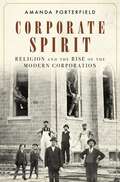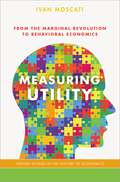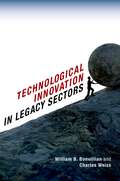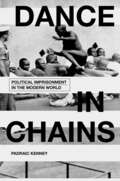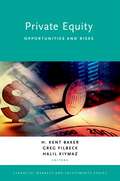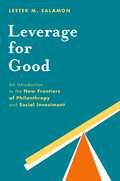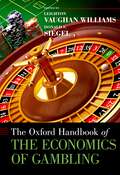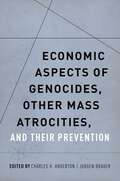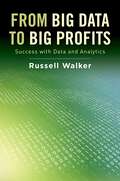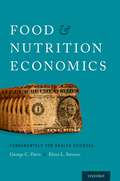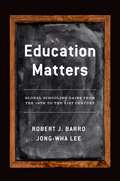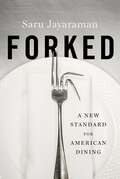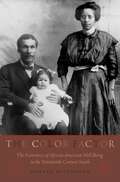- Table View
- List View
Corporate Spirit: Religion and the Rise of the Modern Corporation
by Amanda PorterfieldIn this groundbreaking work, Amanda Porterfield explores the long intertwining of religion and commerce in the history of incorporation in the United States. Beginning with the antecedents of that history in western Europe, she focuses on organizations to show how corporate strategies in religion and commerce developed symbiotically, and how religion has influenced the corporate structuring and commercial orientation of American society. Porterfield begins her story in ancient Rome. She traces the development of corporate organization through medieval Europe and Elizabethan England and then to colonial North America, where organizational practices derived from religion infiltrated commerce, and commerce led to political independence. Left more to their own devices than under British law, religious groups in the United States experienced unprecedented autonomy that facilitated new forms of communal governance and new means of broadcasting their messages. As commercial enterprise expanded, religious organizations grew apace, helping many Americans absorb the shocks of economic turbulence, and promoting new conceptions of faith, spirit, and will power that contributed to business. Porterfield highlights the role that American religious institutions played a society increasingly dominated by commercial incorporation and free market ideologies. She also shows how charitable impulses long nurtured by religion continued to stimulate reform and demand for accountability.
Measuring Utility: From the Marginal Revolution to Behavioral Economics (Oxford Studies in History of Economics)
by Ivan MoscatiUtility is a key concept in the economics of individual decision-making. However, utility is not measurable in a straightforward way. As a result, from the very beginning there has been debates about the meaning of utility as well as how to measure it. This book is an innovative investigation of how these arguments changed over time. Measuring Utility reconstructs economists' ideas and discussions about utility measurement from 1870 to 1985, as well as their attempts to measure utility empirically. The book brings into focus the interplay between the evolution of utility analysis, economists' ideas about utility measurement, and their conception of what measurement in general means. It also explores the relationships between the history of utility measurement in economics, the history of the measurement of sensations in psychology, and the history of measurement theory in general. Finally, the book discusses some methodological problems related to utility measurement, such as the epistemological status of the utility concept and its measures. The first part covers the period 1870-1910, and discusses the issue of utility measurement in the theories of Jevons, Menger, Walras and other early utility theorists. Part II deals with the emergence of the notions of ordinal and cardinal utility during the period 1900-1945, and discusses two early attempts to give an empirical content to the notion of utility. Part III focuses on the 1945-1955 debate on utility measurement that was originated by von Neumann and Morgenstern's expected utility theory (EUT). Part IV reconstructs the experimental attempts to measure the utility of money between 1950 and 1985 within the framework provided by EUT. This historical and epistemological overview provides keen insights into current debates about rational choice theory and behavioral economics in the theory of individual decision-making and the philosophy of economics.
MEASURING UTILITY OSHEC C: From the Marginal Revolution to Behavioral Economics (Oxford Studies in History of Economics)
by Ivan MoscatiUtility is a key concept in the economics of individual decision-making. However, utility is not measurable in a straightforward way. As a result, from the very beginning there has been debates about the meaning of utility as well as how to measure it. This book is an innovative investigation of how these arguments changed over time. Measuring Utility reconstructs economists' ideas and discussions about utility measurement from 1870 to 1985, as well as their attempts to measure utility empirically. The book brings into focus the interplay between the evolution of utility analysis, economists' ideas about utility measurement, and their conception of what measurement in general means. It also explores the relationships between the history of utility measurement in economics, the history of the measurement of sensations in psychology, and the history of measurement theory in general. Finally, the book discusses some methodological problems related to utility measurement, such as the epistemological status of the utility concept and its measures. The first part covers the period 1870-1910, and discusses the issue of utility measurement in the theories of Jevons, Menger, Walras and other early utility theorists. Part II deals with the emergence of the notions of ordinal and cardinal utility during the period 1900-1945, and discusses two early attempts to give an empirical content to the notion of utility. Part III focuses on the 1945-1955 debate on utility measurement that was originated by von Neumann and Morgenstern's expected utility theory (EUT). Part IV reconstructs the experimental attempts to measure the utility of money between 1950 and 1985 within the framework provided by EUT. This historical and epistemological overview provides keen insights into current debates about rational choice theory and behavioral economics in the theory of individual decision-making and the philosophy of economics.
Technological Innovation in Legacy Sectors
by William B. Bonvillian Charles WeissThe American economy faces two deep problems: expanding innovation and raising the rate of quality job creation. Both have roots in a neglected problem: the resistance of Legacy economic sectors to innovation. While the U.S. has focused its policies on breakthrough innovations to create new economic frontiers like information technology and biotechnology, most of its economy is locked into Legacy sectors defended by technological/ economic/ political/ social paradigms that block competition from disruptive innovations that could challenge their models. Americans like to build technology "covered wagons" and take them "out west" to open new innovation frontiers; we don't head our wagons "back east" to bring innovation to our Legacy sectors. By failing to do so, the economy misses a major opportunity for innovation, which is the bedrock of U.S. competitiveness and its standard of living. Technological Innovation in Legacy Sectors uses a new, unifying conceptual framework to identify the shared features underlying structural obstacles to innovation in major Legacy sectors: energy, air and auto transport, the electric power grid, buildings, manufacturing, agriculture, health care delivery and higher education, and develops approaches to understand and transform them. It finds both strengths and obstacles to innovation in the national innovation environments - a new concept that combines the innovation system and the broader innovation context - for a group of Asian and European economies. Manufacturing is a major Legacy sector that presents a particular challenge because it is a critical stage in the innovation process. By increasingly offshoring production, the U.S. is losing important parts of its innovation capacity. "Innovate here, produce here," where the U.S. took all the gains of its strong innovation system at every stage, is being replaced by "innovate here, produce there," which threatens to lead to "produce there, innovate there." To bring innovation to Legacy sectors, authors William Bonvillian and Charles Weiss recommend that policymakers focus on all stages of innovation from research through implementation. They should fill institutional gaps in the innovation system and take measures to address structural obstacles to needed disruptive innovations. In the specific case of advanced manufacturing, the production ecosystem can be recreated to reverse "jobless innovation" and add manufacturing-led innovation to the U.S.'s still-strong, research-oriented innovation system.
Technological Innovation in Legacy Sectors
by William B. Bonvillian Charles WeissThe American economy faces two deep problems: expanding innovation and raising the rate of quality job creation. Both have roots in a neglected problem: the resistance of Legacy economic sectors to innovation. While the U.S. has focused its policies on breakthrough innovations to create new economic frontiers like information technology and biotechnology, most of its economy is locked into Legacy sectors defended by technological/ economic/ political/ social paradigms that block competition from disruptive innovations that could challenge their models. Americans like to build technology "covered wagons" and take them "out west" to open new innovation frontiers; we don't head our wagons "back east" to bring innovation to our Legacy sectors. By failing to do so, the economy misses a major opportunity for innovation, which is the bedrock of U.S. competitiveness and its standard of living. Technological Innovation in Legacy Sectors uses a new, unifying conceptual framework to identify the shared features underlying structural obstacles to innovation in major Legacy sectors: energy, air and auto transport, the electric power grid, buildings, manufacturing, agriculture, health care delivery and higher education, and develops approaches to understand and transform them. It finds both strengths and obstacles to innovation in the national innovation environments - a new concept that combines the innovation system and the broader innovation context - for a group of Asian and European economies. Manufacturing is a major Legacy sector that presents a particular challenge because it is a critical stage in the innovation process. By increasingly offshoring production, the U.S. is losing important parts of its innovation capacity. "Innovate here, produce here," where the U.S. took all the gains of its strong innovation system at every stage, is being replaced by "innovate here, produce there," which threatens to lead to "produce there, innovate there." To bring innovation to Legacy sectors, authors William Bonvillian and Charles Weiss recommend that policymakers focus on all stages of innovation from research through implementation. They should fill institutional gaps in the innovation system and take measures to address structural obstacles to needed disruptive innovations. In the specific case of advanced manufacturing, the production ecosystem can be recreated to reverse "jobless innovation" and add manufacturing-led innovation to the U.S.'s still-strong, research-oriented innovation system.
Dance in Chains: Political Imprisonment in the Modern World
by Padraic KenneyStates around the world imprison people for their beliefs or politically-motivated actions. Oppositional movements of all stripes celebrate their comrades behind bars. Yet they are more than symbols of repression and human rights. Dance in Chains examines the experiences of political prisoners themselves in order to understand who they are, what they do, and why it matters. This is the first book to trace the history of modern political imprisonment from its origins in the mid-nineteenth century. The letters, diaries, and memoirs of political prisoners, as well as the records of regime policies, relate the contest in the prison cell to political conflicts between regime and opposition. Padraic Kenney draws on examples from regimes ranging from communist and fascist to colonial and democratic, including Ireland, the United Kingdom, Poland, and South Africa. They include the Fenian Brotherhood, imprisoned in England and Ireland in the 1860s, and their successors during the Irish War of Independence and the Northern Ireland Troubles; Afrikaaners suspected of treason during the Boer War; socialists fighting for Polish freedom in the Russian Empire, and then Communists denouncing "bourgeois" rule in newly-independent Poland; the opponents of apartheid South Africa and stalinist Poland; and those imprisoned by the United States in Guantanamo Bay detention camp today. Some prisons are well-known; in others, inmates suffered in obscurity. Through self-organization, education, and actions ranging from solitary non-cooperation to mass hunger strikes, these prisoners transform their incarceration and counter states' efforts to control them. While considering the international movements that have sought to publicize the plight of political prisoners, Dance in Chains examines the actions of the prisoners themselves to find universal answers to questions about the meaning and purpose of their imprisonment.
Dance in Chains: Political Imprisonment in the Modern World
by Padraic KenneyStates around the world imprison people for their beliefs or politically-motivated actions. Oppositional movements of all stripes celebrate their comrades behind bars. Yet they are more than symbols of repression and human rights. Dance in Chains examines the experiences of political prisoners themselves in order to understand who they are, what they do, and why it matters. This is the first book to trace the history of modern political imprisonment from its origins in the mid-nineteenth century. The letters, diaries, and memoirs of political prisoners, as well as the records of regime policies, relate the contest in the prison cell to political conflicts between regime and opposition. Padraic Kenney draws on examples from regimes ranging from communist and fascist to colonial and democratic, including Ireland, the United Kingdom, Poland, and South Africa. They include the Fenian Brotherhood, imprisoned in England and Ireland in the 1860s, and their successors during the Irish War of Independence and the Northern Ireland Troubles; Afrikaaners suspected of treason during the Boer War; socialists fighting for Polish freedom in the Russian Empire, and then Communists denouncing "bourgeois" rule in newly-independent Poland; the opponents of apartheid South Africa and stalinist Poland; and those imprisoned by the United States in Guantanamo Bay detention camp today. Some prisons are well-known; in others, inmates suffered in obscurity. Through self-organization, education, and actions ranging from solitary non-cooperation to mass hunger strikes, these prisoners transform their incarceration and counter states' efforts to control them. While considering the international movements that have sought to publicize the plight of political prisoners, Dance in Chains examines the actions of the prisoners themselves to find universal answers to questions about the meaning and purpose of their imprisonment.
Private Equity: Opportunities and Risks (Financial Markets and Investments)
During the past few decades, private equity (PE) has attracted considerable attention from investors, practitioners, and academicians. In fact, a substantial literature on PE has emerged. PE offers benefits for institutional and private wealth management clients including diversification and enhancement of risk-adjusted returns. However, several factors such as liquidity concerns, regulatory restrictions, and the lack of transparency limit the attractiveness of some PE options to investors. The latest volume in the Financial Markets and Investments Series, Private Equity: Opportunities and Risks offers a synthesis of the theoretical and empirical literature on PE in both emerging and developed markets. Editors H. Kent Baker, Greg Filbeck, Halil Kiymaz and their co-authors examine PE and provide important insights about topics such as major types of PE (venture capital, leveraged buyouts, mezzanine capital, and distressed debt investments), how PE works, performance and measurement, uses and structure, and trends in the market. Readers can gain an in-depth understanding about PE from academics and practitioners from around the world. Private Equity: Opportunities and Risks provides a fresh look at the intriguing yet complex subject of PE. A group of experts takes readers through the core topics and issues of PE, and also examines the latest trends and cutting-edge developments in the field. The coverage extends from discussing basic concepts and their application to increasingly complex and real-world situations. This new and intriguing examination of PE is essential reading for anyone hoping to gain a better understanding of PE, from seasoned professionals to those aspiring to enter the demanding world of finance.
LEVERAGE FOR GOOD C: An Introduction to the New Frontiers of Philanthropy and Social Investment
by Lester M. SalamonWith the resources of both governments and traditional philanthropy barely growing or in decline, yet the problems of poverty, ill-health, and environmental degradation ballooning daily, new models for financing social and environmental objectives are urgently needed. Fortunately, a revolution is underway in the instruments and institutions available to meet this need. Loans, loan guarantees, private equity, barter arrangements, social stock exchanges, bonds, social secondary markets, and investment funds are just some of the actors and tools occupying the new frontiers of philanthropy and social investment. Together they hold the promise of leveraging for social and environmental purposes not just the billions of dollars of charitable grants but the hundreds of billions, indeed trillions, of dollars of private investment capital. While the changes under way are inspiring, they remain largely uncharted. This concise introduction to the topic, and its companion volume, provide the first comprehensive and accessible roadmap to these important advances. In the process, these works will better equip investors, philanthropists, social entrepreneurs, nonprofit leaders, business executives, government officials, and students the world over to capture the opportunities that these developments hold out to them and to our world.
The Oxford Handbook of the Economics of Gambling (Oxford Handbooks)
by Leighton Vaughan WilliamsThere is growing interest among academics and policymakers in the economics of gambling, which has been stimulated by major regulatory and tax changes in the U.S., U.K. Continental Europe, Asia, Australia and elsewhere. Unfortunately, there is no comprehensive source of path-breaking research on this topic. To fill this gap, we commissioned chapters from leading economists on all aspects of gambling research. Topics covered include the optimal taxation structure for various forms of gambling, factors influencing the demand and supply of gambling services, forecasting of gambling trends, regulation of gambling, the efficiency of racetrack and sports betting markets, gambling prevalence and behavior, modeling the demand for gambling services, the economic impact of gambling, substitution and complementarities among different types of gambling activity, and the relationship between gambling and other sectors of the economy. These are all important issues, with significant global implications. Specifically, we divide the Handbook into sections on casinos, sports betting, horserace betting, betting strategy, motivation, behavior and decision-making in betting markets, prediction markets and political betting, and lotteries and gambling machines
The Oxford Handbook of the Economics of Gambling (Oxford Handbooks)
by Donald S. Siegel Leighton Vaughan WilliamsThere is growing interest among academics and policymakers in the economics of gambling, which has been stimulated by major regulatory and tax changes in the U.S., U.K. Continental Europe, Asia, Australia and elsewhere. Unfortunately, there is no comprehensive source of path-breaking research on this topic. To fill this gap, we commissioned chapters from leading economists on all aspects of gambling research. Topics covered include the optimal taxation structure for various forms of gambling, factors influencing the demand and supply of gambling services, forecasting of gambling trends, regulation of gambling, the efficiency of racetrack and sports betting markets, gambling prevalence and behavior, modeling the demand for gambling services, the economic impact of gambling, substitution and complementarities among different types of gambling activity, and the relationship between gambling and other sectors of the economy. These are all important issues, with significant global implications. Specifically, we divide the Handbook into sections on casinos, sports betting, horserace betting, betting strategy, motivation, behavior and decision-making in betting markets, prediction markets and political betting, and lotteries and gambling machines
Economic Aspects of Genocides, Other Mass Atrocities, and Their Prevention
Alongside other types of mass atrocities, genocide has received extensive scholarly, policy, and practitioner attention. Missing, however, is the contribution of economists to better understand and prevent such crimes. This edited collection by 41 accomplished scholars examines economic aspects of genocides, other mass atrocities, and their prevention. Chapters include numerous case studies (e.g., California's Yana people, Australia's Aborigines peoples, Stalin's killing of Ukrainians, Belarus, the Holocaust, Rwanda, DR Congo, Indonesia, Pakistan, Colombia, Mexico's drug wars, and the targeting of suspects during the Vietnam war), probing literature reviews, and completely novel work based on extraordinary country-specific datasets. Also included are chapters on the demographic, gendered, and economic class nature of genocide. Replete with research- and policy-relevant findings, new insights are derived from behavioral economics, law and economics, political economy, macroeconomic modeling, microeconomics, development economics, industrial organization, identity economics, and other fields. Analytical approaches include constrained optimization theory, game theory, and sophisticated statistical work in data-mining, econometrics, and forecasting. A foremost finding of the book concerns atrocity architects' purposeful, strategic use of violence, often manipulating nonrational proclivities among ordinary people to sway their participation in mass murder. Relatively understudied in the literature, the book also analyzes the options of victims before, during, and after mass violence. Further, the book shows how well-intended prevention efforts can backfire and increase violence, how wrong post-genocide design can entrench vested interests to reinforce exclusion of vulnerable peoples, and how businesses can become complicit in genocide. In addition to the necessity of healthy opportunities in employment, education, and key sectors in prevention work, the book shows why new genocide prevention laws and institutions must be based on reformulated incentives that consider insights from law and economics, behavioral economics, and collective action economics.
From Big Data to Big Profits: Success with Data and Analytics
by Russell WalkerTechnological advancements in computing have changed how data is leveraged by businesses to develop, grow, and innovate. In recent years, leading analytical companies have begun to realize the value in their vast holdings of customer data and have found ways to leverage this untapped potential. Now, more firms are following suit and looking to monetize Big Data for big profits. Such changes will have implications for both businesses and consumers in the coming years. In From Big Data to Big Profits, Russell Walker investigates the use of Big Data to stimulate innovations in operational effectiveness and business growth. Walker examines the nature of Big Data and how businesses can use it to create new monetization opportunities. Using case studies of Apple, Netflix, Google, LinkedIn, Zillow, Amazon, and other leaders in the use of Big Data, Walker explores how digital platforms such as mobile apps and social networks are changing the nature of customer interactions and the way Big Data is created and used by companies. Such changes, as Walker points out, will require careful consideration of legal and unspoken business practices as they affect consumer privacy. Companies looking to develop a Big Data strategy will find great value in the SIGMA framework, which he has developed to assess companies for Big Data readiness and provide direction on the steps necessary to get the most from Big Data. Rigorous and meticulous, From Big Data to Big Profits is a valuable resource for students, researchers, and professionals with an interest in Big Data, digital platforms, and analytics
Food and Nutrition Economics: Fundamentals for Health Sciences (Food and Public Health)
by George C. Davis Elena L. SerranoWinner of the 2017 Quality of Communication Award presented by The Agricultural and Applied Economics Association As the importance of food and nutrition becomes more widely recognized by practitioners and researchers in the health sciences, one persisting gap in the knowledge base remains: what are the economic factors that influence our food and our health? Food and Nutrition Economics offers a much-needed resource for non-economists looking to understand the basic economic principles that govern our food and nutritional systems. Comprising both a quick grounding in nutrition with the fundamentals of economics and expert applications to food systems, it is a uniquely accessible and much-needed bridge between previously disparate scholarly and professional fields. This book is intended for upper level undergraduates, graduate students, and health professionals with no background in economics who recognize that economics affects much of their work. Concerned because previous encounters with economics have been hampered by math hurdles? Don't be; this book offers a specialized primer in consumer economics (including behavioral economics of food consumption), producer economics, market-level analysis, cost-effectiveness, and cost-benefit analysis, all in an accessible and conversational manner that requires nothing more than middle-school math acumen. Grounding these lessons in contemporary issues such as soft drink taxes, food prices, convenience, nutrition education programs, and the food environment, Food and Nutrition Economics is an innovative and needed entry in the rapidly expanding universe of food studies, health science, and their related fields.
Food and Nutrition Economics: Fundamentals for Health Sciences (Food and Public Health)
by George C. Davis Elena L. SerranoWinner of the 2017 Quality of Communication Award presented by The Agricultural and Applied Economics Association As the importance of food and nutrition becomes more widely recognized by practitioners and researchers in the health sciences, one persisting gap in the knowledge base remains: what are the economic factors that influence our food and our health? Food and Nutrition Economics offers a much-needed resource for non-economists looking to understand the basic economic principles that govern our food and nutritional systems. Comprising both a quick grounding in nutrition with the fundamentals of economics and expert applications to food systems, it is a uniquely accessible and much-needed bridge between previously disparate scholarly and professional fields. This book is intended for upper level undergraduates, graduate students, and health professionals with no background in economics who recognize that economics affects much of their work. Concerned because previous encounters with economics have been hampered by math hurdles? Don't be; this book offers a specialized primer in consumer economics (including behavioral economics of food consumption), producer economics, market-level analysis, cost-effectiveness, and cost-benefit analysis, all in an accessible and conversational manner that requires nothing more than middle-school math acumen. Grounding these lessons in contemporary issues such as soft drink taxes, food prices, convenience, nutrition education programs, and the food environment, Food and Nutrition Economics is an innovative and needed entry in the rapidly expanding universe of food studies, health science, and their related fields.
Education Matters: Global Schooling Gains from the 19th to the 21st Century
by Robert J. Barro Jong-Wha LeeEducation has significant and far-reaching effects not only on individuals, but also on the societies in which they live and to which they contribute. The education level of a population affects how a country supports itself and others and the degree to which it can participate in the global field. While everyone from politicians to policymakers to celebrities has stressed the importance of education, there has not been-until now-a vigorous yet comprehensible examination of data to support what has long been common knowledge: education matters. In Education Matters: Global Gains from the 19th to the 21st Century, renowned economists Robert Barro and Jong-Wha Lee present a revolutionary new data set on education in 146 countries since 1870 and projected through 2040. With case studies from the United States, China, and Korea, Barro and Lee evaluate schooling both quantitatively and qualitatively, and assess the role of education in economic and political development. In this comprehensive study, the authors establish the critical role that education plays - particularly for women and girls - in economic growth, fertility, and democracy. The book also addresses sensitive and controversial topics, such as international disparities in education, and the role of education in modernization and development. Both challenging and enlightening, Education Matters has exciting implications for the future of education and promises to be a ground-breaking work in the fields of economics and educational attainment. Engaging and informative, Education Matters is a compelling read for students, scholars, and anyone with a passion for education.
Education Matters: Global Schooling Gains from the 19th to the 21st Century
by Robert J. Barro Jong-Wha LeeEducation has significant and far-reaching effects not only on individuals, but also on the societies in which they live and to which they contribute. The education level of a population affects how a country supports itself and others and the degree to which it can participate in the global field. While everyone from politicians to policymakers to celebrities has stressed the importance of education, there has not been-until now-a vigorous yet comprehensible examination of data to support what has long been common knowledge: education matters. In Education Matters: Global Gains from the 19th to the 21st Century, renowned economists Robert Barro and Jong-Wha Lee present a revolutionary new data set on education in 146 countries since 1870 and projected through 2040. With case studies from the United States, China, and Korea, Barro and Lee evaluate schooling both quantitatively and qualitatively, and assess the role of education in economic and political development. In this comprehensive study, the authors establish the critical role that education plays - particularly for women and girls - in economic growth, fertility, and democracy. The book also addresses sensitive and controversial topics, such as international disparities in education, and the role of education in modernization and development. Both challenging and enlightening, Education Matters has exciting implications for the future of education and promises to be a ground-breaking work in the fields of economics and educational attainment. Engaging and informative, Education Matters is a compelling read for students, scholars, and anyone with a passion for education.
Forked: A New Standard for American Dining
by Saru JayaramanA restaurant critic can tell you about the chef. A menu can tell you about the farm-sourced ingredients. Now who's going to tell you about the people preparing your meal? From 2015 James Beard Leadership Award winner Saru Jayaraman, Forked is an enlightening examination of what we don't talk about when we talk about restaurants: Is the line cook working through a case of stomach flu because he doesn't get paid sick days? Is the busser not being promoted because he speaks with an accent? Is the server tolerating sexual harassment because tips are her only income? As most corporate restaurants continue to set low standards for worker wages and benefits, a new class of chefs and restaurateurs is working to foster sustainability in their food and their employees. Forked offers an insider's view of the highest--and lowest--scoring restaurants for worker pay and benefits in each sector of the restaurant industry, and with it, a new way of thinking about how and where we eat.
Forked: A New Standard for American Dining
by Saru JayaramanA restaurant critic can tell you about the chef. A menu can tell you about the farm-sourced ingredients. Now who's going to tell you about the people preparing your meal? From 2015 James Beard Leadership Award winner Saru Jayaraman, Forked is an enlightening examination of what we don't talk about when we talk about restaurants: Is the line cook working through a case of stomach flu because he doesn't get paid sick days? Is the busser not being promoted because he speaks with an accent? Is the server tolerating sexual harassment because tips are her only income? As most corporate restaurants continue to set low standards for worker wages and benefits, a new class of chefs and restaurateurs is working to foster sustainability in their food and their employees. Forked offers an insider's view of the highest--and lowest--scoring restaurants for worker pay and benefits in each sector of the restaurant industry, and with it, a new way of thinking about how and where we eat.
Asset Management: A Systematic Approach to Factor Investing (Financial Management Association Survey and Synthesis)
by Andrew AngIn Asset Management: A Systematic Approach to Factor Investing, Professor Andrew Ang presents a comprehensive, new approach to the age-old problem of where to put your money. Years of experience as a finance professor and a consultant have led him to see that what matters aren't asset class labels, but instead the bundles of overlapping risks they represent. Factor risks must be the focus of our attention if we are to weather market turmoil and receive the rewards that come with doing so. Clearly written yet full of the latest research and data, Asset Management is indispensable reading for trustees, professional money managers, smart private investors, and business students who want to understand the economics behind factor risk premiums, to harvest them efficiently in their portfolios, and to embark on the search for true alpha.
Marriage Markets: How Inequality is Remaking the American Family
by June Carbone Naomi CahnThere was a time when the phrase "American family" conjured up a single, specific image: a breadwinner dad, a homemaker mom, and their 2.5 kids living comfortable lives in a middle-class suburb. Today, that image has been shattered, due in part to skyrocketing divorce rates, single parenthood, and increased out-of-wedlock births. But whether it is conservatives bewailing the wages of moral decline and women's liberation, or progressives celebrating the result of women's greater freedom and changing sexual mores, most Americans fail to identify the root factor driving the changes: economic inequality that is remaking the American family along class lines. In Marriage Markets, June Carbone and Naomi Cahn examine how macroeconomic forces are transforming our most intimate and important spheres, and how working class and lower income families have paid the highest price. Just like health, education, and seemingly every other advantage in life, a stable two-parent home has become a luxury that only the well-off can afford. The best educated and most prosperous have the most stable families, while working class families have seen the greatest increase in relationship instability. Why is this so? The book provides the answer: greater economic inequality has profoundly changed marriage markets, the way men and women match up when they search for a life partner. It has produced a larger group of high-income men than women; written off the men at the bottom because of chronic unemployment, incarceration, and substance abuse; and left a larger group of women with a smaller group of comparable men in the middle. The failure to see marriage as a market affected by supply and demand has obscured any meaningful analysis of the way that societal changes influence culture. Only policies that redress the balance between men and women through greater access to education, stable employment, and opportunities for social mobility can produce a culture that encourages commitment and investment in family life. A rigorous and enlightening account of why American families have changed so much in recent decades, Marriage Markets cuts through the ideological and moralistic rhetoric that drives our current debate. It offers critically needed solutions for a problem that will haunt America for generations to come.
The Color Factor: The Economics of African-American Well-Being in the Nineteenth-Century South
by Howard BodenhornDespite the many advances that the United States has made in racial equality over the past half century, numerous events within the past several years have proven prejudice to be alive and well in modern-day America. In one such example, Governor Nikki Haley of South Carolina dismissed one of her principal advisors in 2013 when his membership in the ultra-conservative Council of Conservative Citizens (CCC) came to light. According to the Southern Poverty Law Center, in 2001 the CCC website included a message that read "God is the one who divided mankind into different races.... Mixing the races is rebelliousness against God." This episode reveals America's continuing struggle with race, racial integration, and race mixing-a problem that has plagued the United States since its earliest days as a nation. The Color Factor: The Economics of African-American Well-Being in the Nineteenth-Century South demonstrates that the emergent twenty-first-century recognition of race mixing and the relative advantages of light-skinned, mixed-race people represent a re-emergence of one salient feature of race in America that dates to its founding. Economist Howard Bodenhorn presents the first full-length study of the ways in which skin color intersected with policy, society, and economy in the nineteenth-century South. With empirical and statistical rigor, the investigation confirms that individuals of mixed race experienced advantages over African Americans in multiple dimensions - in occupations, family formation and family size, wealth, health, and access to freedom, among other criteria. The Color Factor concludes that we will not really understand race until we understand how American attitudes toward race were shaped by race mixing. The text is an ideal resource for students, social scientists, and historians, and anyone hoping to gain a deeper understanding of the historical roots of modern race dynamics in America.
COLOR FACTOR C: The Economics of African-American Well-Being in the Nineteenth-Century South
by Howard BodenhornDespite the many advances that the United States has made in racial equality over the past half century, numerous events within the past several years have proven prejudice to be alive and well in modern-day America. In one such example, Governor Nikki Haley of South Carolina dismissed one of her principal advisors in 2013 when his membership in the ultra-conservative Council of Conservative Citizens (CCC) came to light. According to the Southern Poverty Law Center, in 2001 the CCC website included a message that read "God is the one who divided mankind into different races.... Mixing the races is rebelliousness against God." This episode reveals America's continuing struggle with race, racial integration, and race mixing-a problem that has plagued the United States since its earliest days as a nation. The Color Factor: The Economics of African-American Well-Being in the Nineteenth-Century South demonstrates that the emergent twenty-first-century recognition of race mixing and the relative advantages of light-skinned, mixed-race people represent a re-emergence of one salient feature of race in America that dates to its founding. Economist Howard Bodenhorn presents the first full-length study of the ways in which skin color intersected with policy, society, and economy in the nineteenth-century South. With empirical and statistical rigor, the investigation confirms that individuals of mixed race experienced advantages over African Americans in multiple dimensions - in occupations, family formation and family size, wealth, health, and access to freedom, among other criteria. The Color Factor concludes that we will not really understand race until we understand how American attitudes toward race were shaped by race mixing. The text is an ideal resource for students, social scientists, and historians, and anyone hoping to gain a deeper understanding of the historical roots of modern race dynamics in America.
The Economics of Consumption: Theory and Evidence
by Tullio Jappelli Luigi PistaferriConsumption decisions are crucial determinants of business cycles and growth. Knowledge of how consumers respond to the economic environment and how they react to the risks that they encounter during the life-cycle is therefore important for evaluating stabilization policies and the effectiveness of fiscal packages implemented in response to economic downturns or financial crises. In The Economics of Consumption, Tullio Jappelli and Luigi Pistaferri provide a comprehensive examination of the most important developments in the field of consumption decisions and evaluate economic models against empirical evidence. The first part of the book provides the basic ingredients of economic models of consumption decisions. The central part reviews the empirical literature on the effect of income and wealth changes on consumption and on the relevance of precautionary saving and credit market imperfections. The last chapters extend the basic framework to such important areas as bequests, leisure, lifetime uncertainty, and financial sophistication. Jappelli and Pistaferri shed light on important issues, including how consumption responds to changes in economic resources, how economic circumstances and consumers' characteristics influence behavior, and whether consumption inequality depends on income shocks and their persistence.
ECONOMICS OF CONSUMPTION C: Theory and Evidence
by Tullio Jappelli Luigi PistaferriConsumption decisions are crucial determinants of business cycles and growth. Knowledge of how consumers respond to the economic environment and how they react to the risks that they encounter during the life-cycle is therefore important for evaluating stabilization policies and the effectiveness of fiscal packages implemented in response to economic downturns or financial crises. In The Economics of Consumption, Tullio Jappelli and Luigi Pistaferri provide a comprehensive examination of the most important developments in the field of consumption decisions and evaluate economic models against empirical evidence. The first part of the book provides the basic ingredients of economic models of consumption decisions. The central part reviews the empirical literature on the effect of income and wealth changes on consumption and on the relevance of precautionary saving and credit market imperfections. The last chapters extend the basic framework to such important areas as bequests, leisure, lifetime uncertainty, and financial sophistication. Jappelli and Pistaferri shed light on important issues, including how consumption responds to changes in economic resources, how economic circumstances and consumers' characteristics influence behavior, and whether consumption inequality depends on income shocks and their persistence.
